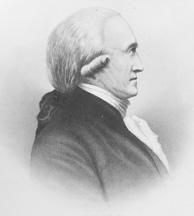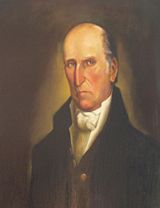
Treaty of Hopewell
Encyclopedia
The Treaty of Hopewell is any of three different treaties signed at Hopewell Plantation
. The plantation was owned by Andrew Pickens
, and was located on the Seneca River
in northwestern South Carolina
. The treaties were signed between the Confederation Congress of the United States of America and the Cherokee
(1785), Choctaw
and Chickasaw
(1786) peoples. The historic site of the 'Treaty Oak', where the signings took place, is on Old Cherry Road in Pickens County, South Carolina. There is a historical marker
placed near the bridge crossing Lake Hartwell
, and a trail through the forest that allows access to the monument. The actual Treaty Oak is no longer alive.
 On November 28, 1785, the first Treaty of Hopewell was signed between the U.S. representative Benjamin Hawkins
On November 28, 1785, the first Treaty of Hopewell was signed between the U.S. representative Benjamin Hawkins
and the Cherokee
Indians. The treaty laid out a western boundary for white settlement. The treaty gave rise to the sardonic Cherokee phrase of Talking Leaves, since they claimed that when the treaties no longer suited the Americans, they would blow away like talking leaves. A description of the boundary is found on Article 4 of the accord:
Included in the signatures of the Cherokee delegation were several from leaders of the Chickamauga/Lower Cherokee
, including two from the town of Chickamauga itself and one from Lookout Mountain Town.

and members of the Cherokee People.
The following lists the terms of the treaty:
1. Indians to restore prisoners (who are U.S. citizens or their allies), slaves, and property.
2. Cherokees acknowledge protection provided by the United States.
3. Boundaries defined.
4. No citizen of United States shall settle on Indian lands and Indians may punish violators as they please.
5. Indians to deliver criminals who commit robbery, murder, or capital crimes.
6. Citizens of United States committing crimes against Indians to be punished.
7. Retaliation restrained.
8. United States to regulate trade.
9. Special provision for trade.
10. Cherokees to give notice of any known designs against United States by tribes or any person.
11. Peace and friendship perpetual.
People.
The following lists the terms of the treaty:
1. Indians to restore prisoners (who are U.S. citizens or their allies), slaves, and property.
2. Choctaws acknowledge protection provided by the United States.
3. Boundaries defined.
4. No citizen of United States shall settle on Indian lands and Indians may punish violators as they please.
5. Indians to deliver criminals who commit robbery, murder, or capital crimes.
6. Citizens of United States committing crimes against Indians to be punished.
7. Retaliation restrained.
8. United States to regulate trade.
9. Special provision for trade.
10. Choctaws to give notice of any known designs against United States by tribes or any person.
11. Peace and friendship perpetual.
The following lists the terms of the treaty:
1. Indians to restore prisoners, slaves, and property.
2. Acknowledge the protection of United States.
3. Boundaries defined.
4. No citizen of United States shall settle on Indian lands and Chickasaws may punish them as they please.
5. Indians to deliver up criminals.
6. Citizens of United States committing crimes against Indians to be punished.
7. Retaliation restrained.
8. United States to regulate trade.
9. Special provision for trade
10. Indians to give notice of any known designs against United States.
11. Peace and friendship perpetual.
Hopewell
-USA:*Hopewell, Alabama *Hopewell, Arkansas *Hopewell, California*Hopewell, Connecticut *Hopewell, Florida...
. The plantation was owned by Andrew Pickens
Andrew Pickens (congressman)
Andrew Pickens was a militia leader in the American Revolution and a member of the United States House of Representatives from South Carolina.-Early life:...
, and was located on the Seneca River
Seneca River (Savannah River)
The Seneca River is created by the confluence of the Keowee River and Twelvemile Creek in northwestern South Carolina, downriver from Lake Keowee near Clemson. It is now entirely inundated by Lake Hartwell, forming a arm of the lake. The Seneca River and the Tugaloo River join to form the Savannah...
in northwestern South Carolina
South Carolina
South Carolina is a state in the Deep South of the United States that borders Georgia to the south, North Carolina to the north, and the Atlantic Ocean to the east. Originally part of the Province of Carolina, the Province of South Carolina was one of the 13 colonies that declared independence...
. The treaties were signed between the Confederation Congress of the United States of America and the Cherokee
Cherokee
The Cherokee are a Native American people historically settled in the Southeastern United States . Linguistically, they are part of the Iroquoian language family...
(1785), Choctaw
Choctaw
The Choctaw are a Native American people originally from the Southeastern United States...
and Chickasaw
Chickasaw
The Chickasaw are Native American people originally from the region that would become the Southeastern United States...
(1786) peoples. The historic site of the 'Treaty Oak', where the signings took place, is on Old Cherry Road in Pickens County, South Carolina. There is a historical marker
Historical marker
A historical marker or historic marker is an indicator such as a plaque or sign to commemorate an event or person of historic interest and to associate that point of interest with a specific locale one can visit.-Description:...
placed near the bridge crossing Lake Hartwell
Lake Hartwell
Lake Hartwell is a reservoir bordering Georgia and South Carolina on the Savannah, Tugaloo, and Seneca Rivers. The lake is created by Hartwell Dam located on the Savannah River seven miles below the point at which the Tugaloo and Seneca Rivers join to form the Savannah...
, and a trail through the forest that allows access to the monument. The actual Treaty Oak is no longer alive.
1785

Benjamin Hawkins
Benjamin Hawkins was an American planter, statesman, and United States Indian agent . He was a delegate to the Continental Congress and a United States Senator from North Carolina, having grown up among the planter elite...
and the Cherokee
Cherokee
The Cherokee are a Native American people historically settled in the Southeastern United States . Linguistically, they are part of the Iroquoian language family...
Indians. The treaty laid out a western boundary for white settlement. The treaty gave rise to the sardonic Cherokee phrase of Talking Leaves, since they claimed that when the treaties no longer suited the Americans, they would blow away like talking leaves. A description of the boundary is found on Article 4 of the accord:
Included in the signatures of the Cherokee delegation were several from leaders of the Chickamauga/Lower Cherokee
Chickamauga Indian
The Chickamauga or Lower Cherokee, were a band of Cherokee who supported Great Britain at the outbreak of the American Revolutionary War. They were followers of the Cherokee chief Dragging Canoe...
, including two from the town of Chickamauga itself and one from Lookout Mountain Town.
1785 - 1786

Cherokees
On November 28, 1785, the first Treaty of Hopewell was signed between U.S. representatives Benjamin Hawkins, Andrew Pickens, and Joseph MartinJoseph Martin (general)
Joseph Martin was a brigadier general in the Virginia militia during the American Revolutionary War, in which Martin's frontier diplomacy with the Cherokee people is credited with averting Indian attacks on the Scotch-Irish settlers who helped win the battles of Kings Mountain and Cowpens...
and members of the Cherokee People.
Cherokee treaty terms
The preamble begins with,The following lists the terms of the treaty:
1. Indians to restore prisoners (who are U.S. citizens or their allies), slaves, and property.
2. Cherokees acknowledge protection provided by the United States.
3. Boundaries defined.
4. No citizen of United States shall settle on Indian lands and Indians may punish violators as they please.
5. Indians to deliver criminals who commit robbery, murder, or capital crimes.
6. Citizens of United States committing crimes against Indians to be punished.
7. Retaliation restrained.
8. United States to regulate trade.
9. Special provision for trade.
10. Cherokees to give notice of any known designs against United States by tribes or any person.
11. Peace and friendship perpetual.
Choctaws
On January 3, 1786, the Treaty of Hopewell was signed between U.S. representatives Benjamin Hawkins, Andrew Pickens, and Joseph Martin and members of the ChoctawChoctaw
The Choctaw are a Native American people originally from the Southeastern United States...
People.
Choctaw treaty terms
The preamble begins with,The following lists the terms of the treaty:
1. Indians to restore prisoners (who are U.S. citizens or their allies), slaves, and property.
2. Choctaws acknowledge protection provided by the United States.
3. Boundaries defined.
4. No citizen of United States shall settle on Indian lands and Indians may punish violators as they please.
5. Indians to deliver criminals who commit robbery, murder, or capital crimes.
6. Citizens of United States committing crimes against Indians to be punished.
7. Retaliation restrained.
8. United States to regulate trade.
9. Special provision for trade.
10. Choctaws to give notice of any known designs against United States by tribes or any person.
11. Peace and friendship perpetual.
Chickasaws
On January 10, 1786, the Treaty of Hopewell was signed between U.S. representatives Benjamin Hawkins, Andrew Pickens, and Joseph Martin and the Chickasaw.Chickasaw treaty terms
The preamble begins with,The following lists the terms of the treaty:
1. Indians to restore prisoners, slaves, and property.
2. Acknowledge the protection of United States.
3. Boundaries defined.
4. No citizen of United States shall settle on Indian lands and Chickasaws may punish them as they please.
5. Indians to deliver up criminals.
6. Citizens of United States committing crimes against Indians to be punished.
7. Retaliation restrained.
8. United States to regulate trade.
9. Special provision for trade
10. Indians to give notice of any known designs against United States.
11. Peace and friendship perpetual.
See also
- Treaty of HolstonTreaty of HolstonThe Treaty of Holston was a treaty between the United States government and the Cherokee signed on July 2, 1791 and proclaimed on February 7, 1792...
- List of Choctaw Treaties
- Treaty of Mount DexterTreaty of Mount DexterThe Treaty of Mount Dexter was signed between the United States and the Choctaws. The treaty was signed November 16, 1805. The area ceded was from the Natchez District to the Tombigbee Alabama River watershed, mostly in present-day Mississippi.-Terms:...
- Treaty of Fort St. StephensTreaty of Fort St. StephensThe Treaty of Fort St. Stephens or Treaty of Choctaw Trading House was signed between the United States and the Choctaws. The treaty was signed at the Choctaw trading house on October 24, 1816. It ceded of Choctaw land east of the Tombigbee River. The land was exchanged for 6,000 US dollars...
- Treaty of Doak's StandTreaty of Doak's StandThe Treaty of Doak's Stand was signed on October 18, 1820 between the United States and the Choctaw Indian tribe. Based on the terms of the accord, the Choctaw agreed to give up approximately one-half of their remaining Choctaw homeland...
- Treaty of Washington CityTreaty of Washington CityThe Treaty of Washington City was a treaty signed on January 20, 1825 between the Choctaw and the United States Government.-Overview:...
- Treaty of Dancing Rabbit CreekTreaty of Dancing Rabbit CreekThe Treaty of Dancing Rabbit Creek was a treaty signed on September 27, 1830 between the Choctaw and the United States Government. This was the first removal treaty carried into effect under the Indian Removal Act...
- List of treaties

